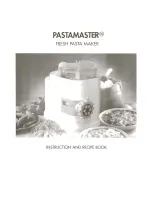
Downloaded from www.vandenborre.be
10
B. Suggestions for the choice of milk
Yogurt can be made from any milk, and you can use all types of
milk with your yogurt maker. The choice will thus depend directly
on your personal preferences.
1. Pasteurised milk of any fat content (rich in fat, %, 1%). This milk
is used most often and gives the best results.
. Powdered milk. This results in a firm yogurt, richer in calcium
and in proteins.
3. Long-life sterilised UHT milk. This results in a relatively firm yo-
gurt without skin.
4. Farm milk. It is advised that you boil this kind of milk before
using it to kill any harmful bacteria. If using goat or sheep milk,
the yogurt produced will not be as firm.
5. Soy milk. Make sure you use UHT soy milk that contains one of
the following ingredients: fructose, honey or malt. One of these
ingredients at least is absolutely necessary.
NOTE: The level of fat and solids in the milk directly affects the
flavour, texture and nutritional value of the final product. Also,
the firmest yogurt is the kind obtained with whole milk. It also
has more flavour, fat content and energy. Skimmed and semi-
skimmed milk result in more fluid yogurt.
C. Tips
• Yogurt made from whole milk will be creamier than that made
from semi-skimmed milk. Note: If you use skimmed milk, it won’t
work!
• UHT milk can be used directly chilled.
• Fresh (farm) milk must be boiled for long enough before using.
Make sure you chill it (to about 43°C) before adding the ferment-
ing agents.
• You can keep the yogurt for between 7 and 10 days in your re-
frigerator, but it is better to eat it within four days of making it.
• People who have an allergy or an intolerance to cow milk can
use goat or soy milk. Goat milk is rich in proteins and easier to
digest.
D. Yogurt recipe from the chefs
• 1 l semi-skimmed milk
• 1 natural yogurt (preferably farm), about 140g
• Semi-skimmed powdered milk (amount: pots from the farm
yogurt that you will be using)
Mix all the ingredients when cold, and then pour into the pots
provided. Place the pots in the yogurt maker and allow to cook for
9 hours. Cover the pots again with the lids and allow to chill for at
least four hours in the refrigerator before eating.
• Make sure the unit has cooled completely before cleaning and
storing. Always unplug the unit from the electrical outlet and
clean it carefully before storing.
• The pots, lids and the yogurt maker lid can be washed with hot,
soapy water and dried with a towel or they can be placed on the
top rack of the dishwasher.
• To clean the base and the inside of the yogurt maker, wipe with
a damp cloth. Do not use abrasive cleansers.
• Do not immerse the base of the yogurt maker in water or any
other liquid.
6. SAFETY INSTRUCTIONS
• Keep these instructions for future reference.
• Never immerse the plug, the cord or the motor block in water or
any other liquid.
• Unplug the unit immediately after use, before attaching or re-
moving accessories and before cleaning the unit.
• Avoid any contact with moving parts.
• Never move the unit when it is in operation.
• Do not place the unit on a vibrating surface, like a refrigerator,
or place it in a draft.
• Do not keep yogurt in the refrigerator for longer than 10 days.
• Never place the unit in the refrigerator.
• Do not use the unit if the cord is damaged or if the unit has been
dropped or appears damaged. If the cord is damaged, it should
be replaced by the manufacturer. Return the unit to the manu-
facturer for inspection, repair, or electrical or mechanical adjust-
ment. Do not carry out any repairs yourself.
• Use only accessories provided with the unit.
• Do not allow the cord to dangle from the table or counter. To
avoid all risk of damage, do not let the cord come in contact with
the hot surfaces.
• IMPORTANT: Do not cover the base of the unit. None of the parts
included with this unit may be repaired or replaced by the user.
Repairs may only be carried out by the manufacturer.
• This unit is not intended for use by adults or children without
experience with or knowledge of the product or whose incapac-
ity may cause danger, unless they have been given instructions
beforehand and are adequately supervised.
• Children should be supervised when using the unit to ensure
they do not use it like a toy.
• This appliance meets the basic requirements of Directives











































